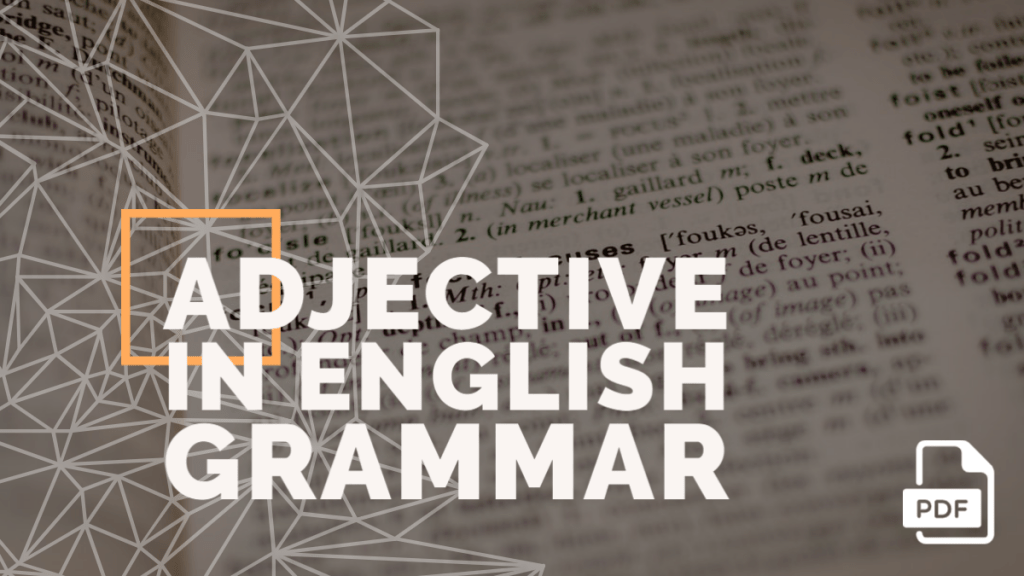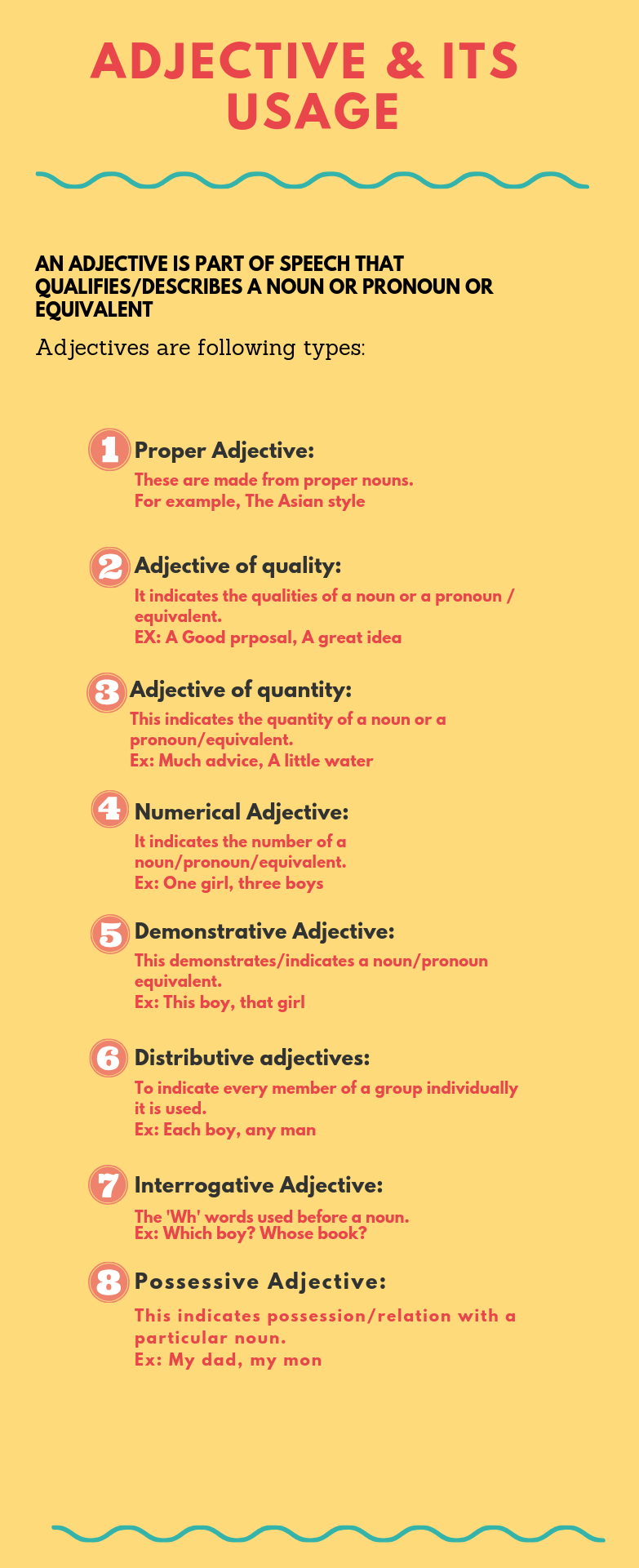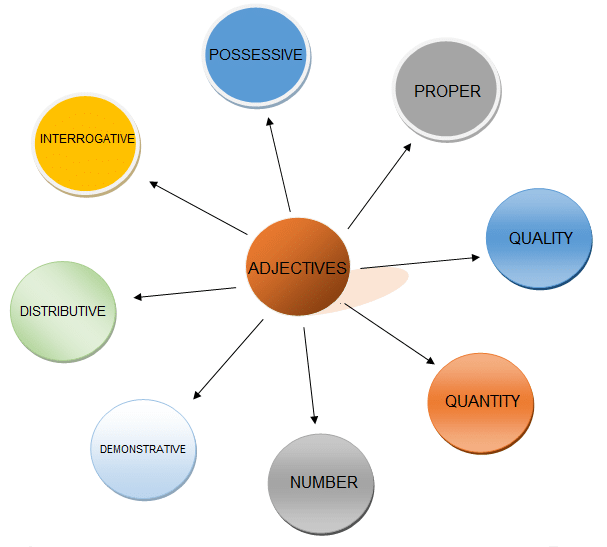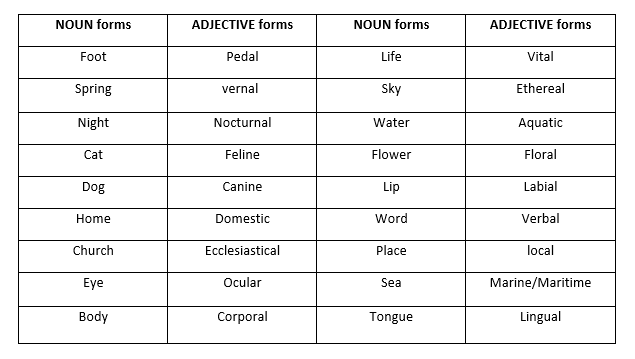Adjective in English Grammar with Examples [PDF]
Hello Learners, so in this lesson, we will discuss What is an Adjective in English Grammar? Then What are the types of adjective? and their example, I think examples are always helpful for understanding the proper usage. So, I designed this topic for you to understand clearly with examples. Hope you like this. So let start with the definition. To download the PDF copy of this lesson, please find the downloadable link attached below this article.

Adjective Definition:
An adjective is a word that qualifies or describes a noun or pronoun or equivalent (Gerund).
For example, let I take a sentence – She is a kind lady. here ‘kind’ represent the quality of the lady, so here kind is used as an adjective. Similarly, take another one- Sam is an honest boy, here also ‘honest’ describe the quality of the boy. I think now you clear to spot out an adjective.
TAKE A LOOK ON THIS INFOGRAPHIC

There are two classes of the adjective:
- Descriptive.
- Determiner.
Position of Adjective:
Descriptive adjectives are used both predictively and attributively and Determiner adjectives are used only before a Noun.
For example,
- He is an honest boy. (Attributive use).
- The boy is honest. (Predicative use).
Here the sense or meaning of the sentence is the same, but the first one is for attributive use and the second one for predicative use.
[The detailed guide by Lexico on Attributive use and Predication Use of Adjective, you can find the resources here.]
Types of Adjective:
Adjectives are classified into eight types:
- Proper adjective.
- Adjective of quality.
- Adjective of quantity.
- Numerical adjective.
- Demonstrative adjective.
- Distributive adjective.
- Interrogative adjective.
- Possessive adjective.

- PROPER ADJECTIVE:
This is made from proper nouns. For example– The Asian style, Punjabi dish.
- ADJECTIVE OF QUALITY:
It indicates the quality of a noun or pronoun/equivalent. For example, A good proposal, A great idea, etc.
- ADJECTIVE OF QUANTITY:
This indicates the quantity of a noun or pronoun or equivalent.
For example, Much advise, A little water, etc.
- NUMBER (Numeral adjective):
Adjectives of a number indicate the number of nouns/pronoun/equivalents. For example, Five boys, Two girls, several things, etc.
- DEMONSTRATIVE ADJECTIVE:
This demonstrates indicates a noun/pronoun or equivalent.
For example, This boy, that girl, these books, etc.
- DISTRIBUTIVE ADJECTIVE:
To particularize or indicates every member of a group individually it is used. For example, each boy, every book, any man, etc.
- INTERROGATIVE ADJECTIVE:
The ‘wh’ word used before a noun is called Interrogative adjective.
For example, Which book? Whose book?
- POSSESSIVE ADJECTIVE:
This indicates relation or possession with a specific noun.
For example, My father, your friend, his books, etc.
SOME OF THE ADJECTIVES THAT WE USE IN DAILY LIFE:
- Quality- Ugly, heavy, dry, good, red.
- Demonstrative – This, that, these, those.
- Quantitative- Some, any, no, little.
- Numerical – Few, many all, several, one, first.
- Interrogative- Which, what, when, who, whose.
- Possessive- My, our, your, her, his, its, their.
- Present/past participle- A moving car, a burnt man, tiring journey.
- Relative- Who, which, that.
- Emphatic- Own, very, such, same.
- Proper- American, Asian, Indian.
- Exclamatory – What, which, How.
So now we are going to learn how to find a difference between Adjectives and Pronouns because the same sense is used for both adjectives and pronoun, it is quite easy. let me show you the difference.
Demonstrative adjectives and Demonstrative pronouns:
- That is my book. So here ‘That’ is Pronoun.
- Please get me that book. And here ‘That’ is Adjective.
Distributive adjectives and Distributive pronoun:
- Either boy has stolen my bicycle. Here ‘either’ is used as an adjective.
- I do not like either of the sisters. And here ‘either’ is used as a pronoun.
Possessive adjectives and Possessive pronouns:
- This is my book. ‘My’ is used as an adjective.
- This book is mine. ‘Mine’ is used as a pronoun.
Though the meaning of both sentences is the same.
So, you see that changing the position of ‘my or mine’, it will use as Adjectives and pronoun as well.
Now I discuss how Nouns can be written as adjectives, I will give you some examples of that which can help you to get some idea about this:

Rules of Adjectives:
Rule 1
Use of little, a little, the little: There are used to denote the little amount of quality.
- Little is used in a negative sense.
- A little is used in a positive sense.
- The little denoted the definite amount or quality.
For example,
- A little knowledge is dangerous.
- I have given him a little water.
Rule 2
There are some objectives which have no comparative or superlative form– Unique, chief, main, prime, absolute, empty, complete, circular, square, etc.
For example,
- The park is more circular in shape.
Rule 3
We know ‘the’ is not used before a comparative degree.
Rule 4
When ‘then’ is not used with a comparative degree, ‘the’ is used before it.
For example,
- He is better than I.
- Ram is the better of the two boys.
Rule 5
In the case of two comparatives ‘the’ is used before them.
For example,
- The higher we go, the cooler it becomes.
Rule 6
Senior, junior, superior, prior, posterior, etc.
These Latin adjectives are followed by ‘to’.
For example,
- My elder brother is senior to me by 4 years.
Rule 7
If positive and comparative degree is used in a sentence, they are joined by ‘if’.
For example,
- He is as good as it not better than Shayam..
A Must Watch Video Lesson on Adjective:
Adjective Exercises:
Point out the adjectives in the following sentences and state which class is of them belongs to –
- Most boys are fond of sweets.
- The wise old man supported by the young boy.
- The good boy obeys his parents.
- I give the poor man some rice and a cloth.
- Few men can raise such a heavy load.
- Which boy did it?
- The cruel King caused great suffering to his people.
- I told the whole story to my aged mother.
- She is the first girl in the class.
- She has a soft heart and cannot stand such a painful sight.
Comment down the answer below, I will Correct those answer for you. And if you liked this lesson on Adjective in English Grammar, do not forget to share this stuff with your friends and help them to learn.
References:
- 11 Types Of Adjectives In English With Examples – 7 E S L
- ADJECTIVES – Basic English Grammar – Parts of Speech Lesson 4 – What is an Adjective? – Grammar by Learn English Lab